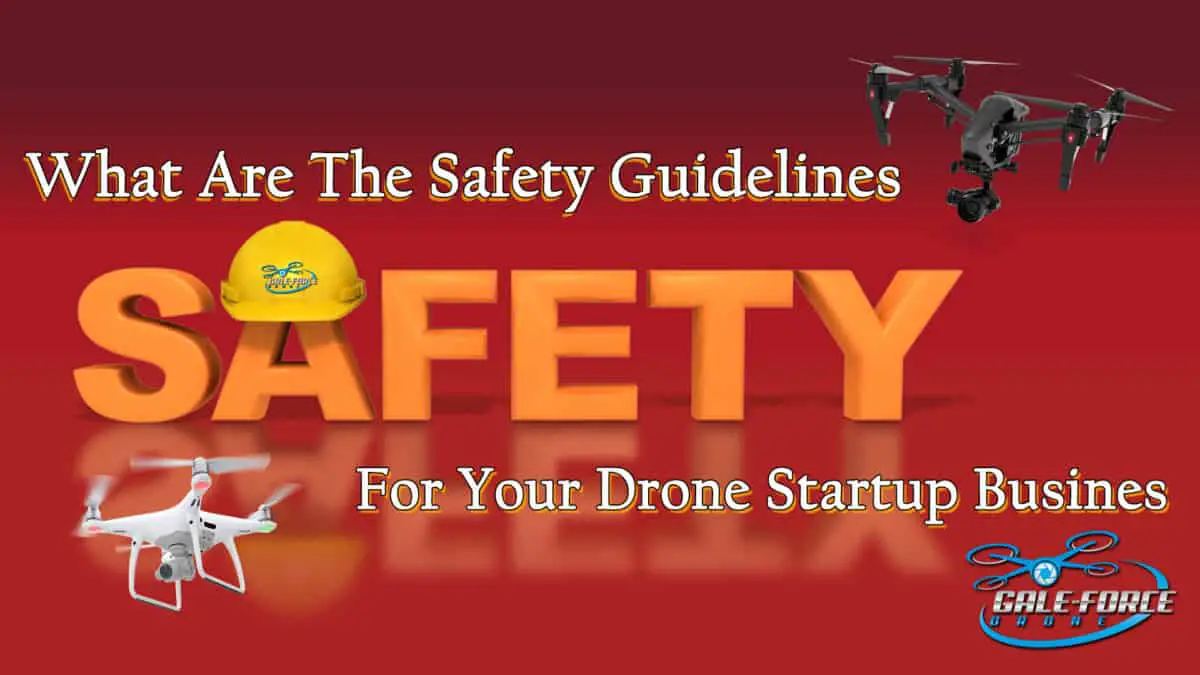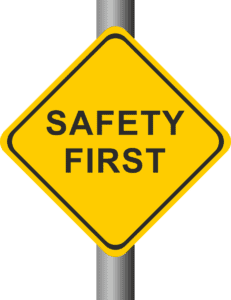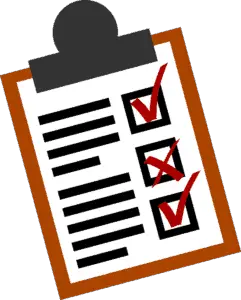
How To Create Your Drone Startup Safety Policy
As a Drone Startup, it is critical that you establish a formal Safety Policy to follow as you go out and perform drone operations in the field. The following Safety Guidelines for your Drone Startup are recognized across the Drone and Aviation Industry and should be considered when creating your internal safety protocols.
- The PAVE Checklist
- The I.M.S.A.F.E. Checklist
It is also a great idea to keep a copy of this document with you in case you are ever approached by and/or questioned by security personnel or law enforcement, as well as for reference during drone operations.
Think About It
 Flying a drone can be an exhilarating experience, even a bit of an adrenaline rush, especially when you are flying over a new or unfamiliar area, offering its unique perspective, as well as potential obstacles.
Flying a drone can be an exhilarating experience, even a bit of an adrenaline rush, especially when you are flying over a new or unfamiliar area, offering its unique perspective, as well as potential obstacles.
The same goes when performing commercial drone operations. This same exhilaration can quickly become a distraction to adherence to safety protocols. It is absolutely imperative that you, and if you have a visual observer, have a well established safety policy and are following it to the letter.
Flying drones whether for pleasure or for commercial operations inherently come with serious risk considerations. Additionally, with the increased popularity and availability of consumer drones, these risks have increased exponentially, just due to a lack of knowledge among hobbyist drone flyers. With this increase, crashes and mid-air collisions with birds, obstacles such as trees and power lines, and other aircraft as well have also increased.
As a commercial drone operator, you will have undergone specialized training in order to test and acquire your sUAS/sUAV pilot certification (required for any commercial or professional drone operations). As part of this training, you will have also been extensively trained on safety regulations as mandated by the country in which you are certified.
Personal/Pilot
 The first factor we should check is the Personal/Pilot Factor. In OSH (Occupational Safety and Health), this is also known as the human factor. In order to assess if you are fit to fly, use the I.M.S.A.F.E. checklist.
The first factor we should check is the Personal/Pilot Factor. In OSH (Occupational Safety and Health), this is also known as the human factor. In order to assess if you are fit to fly, use the I.M.S.A.F.E. checklist.
- Illness – Are you feeling well? Did you have recent illnesses that have affected your spatial orientation?
- Medication – Did you take any medications recently? Do these medications have side-effects that could affect or impair your ability to fly?
- Stress – Are you currently under stress? Stress comes in three forms:
- Physiological stress is stress in the physical sense. It comes from fatigue, strenuous exercise, being out of shape or changing time zones, to name a few. Unhealthy eating habits, illness, and other physical ailments are included in this category, too.
- Environmental stress comes from the immediate surroundings and includes things such as being too hot or too cold, inadequate oxygen levels or loud noises.
- Psychological stress can be more difficult to identify. This category of stress includes anxiety, social and emotional factors and mental fatigue. Psychological stress can occur for many reasons such as divorce, family problems, financial troubles or just a change in schedule.
- Alcohol – Are you under the influence of alcohol? Are you currently experiencing a hangover? The “8 hours from bottle to throttle” rule can be followed but pilots can still be unfit to fly. Flying and alcohol never mix, so make sure that you are completely sober before flying.
- Fatigue – Are you tired? Did you get enough rest? Are you drowsy? Fatigue and drowsiness slow down your reflexes, and can compromise the safety of your flight ops.
- Emotion – Is there something bothering you? Is your mood unusual?
As a professional, it is crucial that you are honest with yourself when going through this honor based checklist and self-examination prior to any drone flight operation. Once you have cleared the I.M.S.A.F.E. checklist and have ensured that you, as a pilot, are fit to fly, it is then that you can proceed to the next step of the PAVE checklist.
Aircraft  After completing your personal assessment, you should assess your drone and associated flight equipment to ensure it is airworthy. Check the following items:
After completing your personal assessment, you should assess your drone and associated flight equipment to ensure it is airworthy. Check the following items:
- Batteries – Make sure that your drone, controller, and tablet/phone/monitor batteries are fully charged.
- Aircraft Structure – Check your drone for any dents, cracks, or missing parts.
- Firmware – Make sure that your drone’s firmware and companion app are updated to the latest version.
- Backup Parts – Make sure that you have backup propellers and other necessary parts, in case something breaks down, to ensure continuity of operations.
- Calibration – Are the following items properly calibrated?
- Global Positioning System (GPS)
- Inertial Measurement Unit (IMU)
- Return to Home (RTH)
- System Instruments
- Maximum Flight Altitude
- Compass
- Signal Strength – A good signal strength is required to ensure proper communication between the controller and the aircraft.
Once you’ve determined that your aircraft is airworthy, it’s time to check the environment.
EnVironment
When operating your drone, you MUST always be aware of your environment. The following is a list of items to consider on the environment that you are operating in. Be sure to add any additional environmental items based on the requirements in your country or region.
- Weather – Check your local news, or weather apps for any rain and windy conditions. Rain can damage the internal components of your drone and potentially disrupt your business, further, the quality of your data output will not usually meet standards if flying in inclement weather. When in an aerodrome, you may check for METARs. Be on the lookout for Notice to Airmen (NOTAMs) for other factors that can affect your flight environment, such as volcanic eruptions.
- Visibility – Always maintain a visual line of sight between you and your drone. Authorities usually don’t allow BVLOS (Beyond Visual Line of Sight) operations without a waiver.
- Obstacles – Be sure to fly clear of obstacles and maintain a minimum safe distance of no less than 30 meters from anyone not associated with the flight operation.
- Altitude – Be sure to fly no higher than 400 feet.
- Authorizations/Waivers – Where required, always seek permission from local authorities before flying, as a lack of coordination may cause undue alarm to residents, especially in private subdivisions and urban environments.
- Airports – Do not fly within 10 kilometers or 5 miles of any airport. If this is unavoidable, you are required to obtain prior authorization first, and make sure to coordinate with ATC (Air Traffic Control) during all phases of operation.
- Powerlines/Towers – Stay clear of power lines. They emit EMI (electromagnetic interference), which most drones are not designed to resist. EMI can severly damage, if not destroy your drone’s internal circuitry and cause irreparable damage.
Once you have deemed your flight environment to be safe for flying, you must check for external pressures.
External Pressures
External pressures are  factors outside of the normal planned flight that may cause pressure on the pilot to complete the flight. Examples include; client requirements, trying to impress a friend, or desiring to obtain a personal goal. To evaluate yourself for external pressures, ask yourself the following questions:
factors outside of the normal planned flight that may cause pressure on the pilot to complete the flight. Examples include; client requirements, trying to impress a friend, or desiring to obtain a personal goal. To evaluate yourself for external pressures, ask yourself the following questions:
- Do you need to fly today? Should you fly today?
- Are you feeling pressured to meet certain deadlines?
- Do you have a plan B?
Once you have cleared all aforementioned factors, then you are on the way to flying your drone safely. However, during the flight, some unexpected things may happen, also known as emergencies.
Emergencies – When an in-flight emergency arises, always follow the general rule “AVIATE, NAVIGATE, COMMUNICATE”.
- Aviate – maintain or regain control of the aircraft
- Navigate – decide where to land if a return to the take-off point is not possible
- Communicate – alert appropriate authorities on your situation.
In Conclusion
As you can see, there are many considerations that need to be taken when going out into the field to perform drone operations. Drones can be exceptionally dangerous if safety guidelines are not established and observed consistently. Even if you are just flying for pleasure is no reason to let your guard down and ignore your safety protocols. Further, as certified airmen, we carry a certain responsibility to maintain every safety, and be an influence and good example on how drones should be flown.
Let’s ALL do our part in being a good Drone Steward and representative of the Drone Community.
Click Here For Guidance To Launch Your Drone Startup
How To Get Your FAA Part 107 Pilot Certification
If you are serious about making money with your drone, whether it be Real Estate, Aerial Inspections, etc., then you will need, from the FAA a 14 CFR Part 107 certification.
The best source for your training can be found by clicking on RemotePilot101. Jason Schappert is a pilot and author of 8 best-selling aviation flight training books. While studying and taking tests is not the most fun, Jason breaks it down into 10 easy to follow (at your own pace) video lessons. These lessons are straight and to the point giving you the exact knowledge, nothing less, nothing more than what you need to pass the exam. Additionally, he is continually updating the training to keep it relevant to any changes to FAA regulations. This membership is a 1-time subscription – for life! So when you’re 24 month renewal comes around, just sign in to RemotePilot101 and refresh your training.
Just remember, if you are flying commercially, you will need your Part 107 certification. It’s not hard, you can do it!



